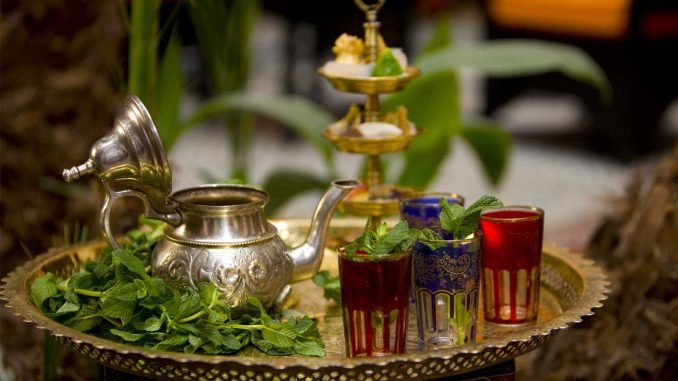An essential drink if you visit Morocco, mint tea is a classic of Moroccan culture. A sign of hospitality when offered to guests, nectar with healing properties or even a symbol of North African culture, Moroccan mint tea has different facets. Discover them here!

The History of Moroccan Mint Tea
While one might believe that tea culture is ancient due to tea consumption being very anchored in Moroccan culture, it is in fact relatively recent.
The oldest texts written by Arabs mentioning tea date back to the 9th century: it was a merchant who mentioned it in his travel report in China. Following this, in the 16th century, tea traveled from China to Egypt via Pakistan, Iran and the Arabian Peninsula, but did not reach Morocco.

As is often the case with the integration of oriental foods, tea was first introduced to the court of a sultan, but it was the British India Company which really allowed its diffusion in the country. In the colonies – especially in India and Indochina – tea production increased and Moroccans, who already consumed a lot of mint, decided to combine the two foods. Moroccan Mint tea has for that reason just been taken in en masse given that the 19th century.
Traditions linked to Moroccan Mint Tea
Today, offering mint tea to your guests is an almost obligatory step in showing hospitality and refusing a glass of tea is impossible, or very frowned upon. A Touareg proverb says “You need three conditions to make tea: time, embers and friends”.

In Morocco, it is the men who prepare the tea, according to a particular know-how: the leaves are “washed” in hot water, to eliminate the tannin, a substance giving the bitter taste to the tea. Concerning the service, pouring the tea from above as the Moroccans do so skillfully allows it to be oxygenated and, thus, reveal all its aromas.
The tea is served three times, without the leaves being changed. A proverb says: “The very first beverage is bitter like life, the 2nd is as pleasant as love and the third is as calming as fatality”.
Mint tea in the Maghreb
Mint tea is drunk throughout the Maghreb, but practices and preparation differ between countries and peoples. Some add more or less sugar or serve the tea with a mint leaf in the glass.

In Tunisia, for example, pine nuts are added to tea to add flavor to the beverage. In the Taliouine region, where saffron is produced, locals add a few filaments of the precious spice to their tea at the start of preparation. The Berbers add a lot of aromatic plants to their tea, and some even say that it is not possible to drink good tea in Marrakech because they do not have enough taste.
Go to a Moroccan tea room in Marrakech
To taste the famous drink, prepared by experts in the field, visit an on-site tea room. You will be able to have a glimpse of the local gastronomy and enjoy your tea accompanied by a pastry.

A must-see in Marrakech and world-famous, the Pâtisserie des Princes is frequented by tourists and locals, a sign of the quality of its pastries and Moroccan tea. A stone’s throw from Jemaa el-Fna square, take a break and taste gazelle horns flavored with orange blossom, chebakias or baklavas overflowing with sugar and almond paste. Consider bringing a plastic box if you plan to bring pastries back to your family in France. Pastries are sold for around €20 per kilo.
How to prepare a Moroccan Mint Tea at home?
For tea lovers, it is possible to prepare Moroccan Mint tea at home. You will feel like you are traveling for just one drink.
Ingredients :
- 2 spoons of green tea (between 10 and 12g)1 bunch of fresh mintSome waterA few pieces of sugar

Pour the equivalent of half a glass of boiling water over the tea leaves previously placed in a teapot to rinse them. This helps eliminate tannin, which gives a bitter taste to the tea. Wait a minute, then remove the water.
Bring the water to a simmer (be careful not to boil it) and wash the mint leaves during this time. Pour the simmering water into the teapot and remove it from the heat.
Add the tea leaves and sugar off the heat then mix. If the tea cooks, all its aromas will be lost. Tip: to mix without a spoon, as the Moroccans do, pour the tea into a glass then into the teapot several times in a row.
Leave to infuse for about 5 minutes then serve, placing the teapot well above the glass: this oxygenates the tea and allows the formation of the “turban” (the small foam on the surface), a sign of a successful tea and lucky for the guest.



